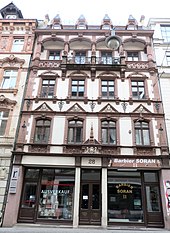Friedrich Fahro
Friedrich Fahro (born October 31, 1857 in Halle (Saale) ; † August 1930 there ; full name: Carl Hermann Friedrich Fahro ) was a German architect and church builder.
Life
Fahro was probably born as the eldest of four children of the carpenter Johann Georg Friedrich Fahro and his wife Friederike Wilhelmine Amalie nee Müller. After completing a three-year apprenticeship as a carpenter, he enrolled at the Technical University of Hanover from 1881 to 1883 , where he attended several courses as an intern with the respected church builder Conrad Wilhelm Hase .
After working in various architectural offices, Fahro became a partner of Gustav Brumme (1857–1913) in 1886 at Brumme & Fahro, a studio for architecture and applied arts. His “Atelier for Architecture and Building Execution”, which he ran alone from 1888, had been in the house at Grosse Ulrichstrasse 28, built in 1890/91, since 1892.
In the following years his good reputation as a master builder and architect was consolidated, so that he also gained the trust of the princes in Stolberg-Roßla , as their chief builder he was named in 1904.
In 1906 he became a member of the Hallenser Johannisloge "Friedrich zur Standhaftigkeit" and later rose to the Andreasloge Halle.
Sacred buildings, the majority of which can be classified between Neo-Gothic and Neo-Romantic, can be verified for him until 1907. Many of Fahro's buildings can be assigned to the so-called Hanover School of Architecture , the founder of which was his teacher at the Technical University of Hanover, Conrad Wilhelm Hase.
In the years between 1914 and 1930 Fahro was increasingly busy with the planning and execution of extensions and conversions for the miners' sanatorium in Sülzhayn .
Fahro died in 1930 "caused by an accident" in the surgical clinic in Halle and was buried in the north cemetery.
family
Fahro married Tendora Martha née Hieronymus on October 3, 1887, who died in 1940. His sons Erich Fritz and Fritz Wolfram were born in 1888 and 1890. The daughter Hildegard Martha was baptized as the first child on November 11, 1893, one day after the inauguration, in the Johanneskirche. In 1896 the third son Johannes Fritz was born. The daughter Hildegard died in 1914; the eldest son Erich in 1947.
Awards
- Prussian Crown Order 4th class
- Herzog Ernst Medal , 1910
plant
Fahro was demonstrably involved in the construction of 27 churches and other objects. This includes:
- 1883–1887: Conversion of the former university clinic on Domplatz in Halle (Saale) to the zoological institute (with O. Kilburger and E. Streichert)
- 1889: Children's institution in Halle (Saale)
- 1892–1893: Johanneskirche in Halle (Saale)
- 1892–1894: Luther Church in Bad Kösen
- Construction plan realized again for the Bonifatius Church in Altenbeichlingen from 1897–1898
- 1893: Institution church of the Diakonie in Halle (Saale) - Fahro followed the Wiesbaden program for the design of Protestant preaching churches with his room layout. The church is given special architectural importance, as it is considered to be one of the earliest examples of this type of room, which had a decisive influence on church construction in the 19th and 20th centuries.
- 1895–1896: Villa Schroedel in Halle (Saale), residential and commercial building for the publisher Hermann Louis Schroedel
- 1896–1897: District building in Sangerhausen
- 1900–1901: Heldrungen Town Hall
- 1900–1902: Chamber of Agriculture of the Province of Saxony in Halle (Saale)
- 1903–1904: Library of the Leopoldine-Carolinian Academy of Natural Scientists in Halle (Saale)
- 1906–1908: Hospital in Kölleda
- 1907: Sülzhayn, chapel of the sanatorium of the North German Knappschafts pension fund
- 1910: Parish hall of the Protestant-Reformed cathedral parish in Halle (Saale)
literature
- Katrin Bisping: The church builder Friedrich Fahro (1857–1930). Unpublished Master's thesis, Anhalt University of Applied Sciences, Dessau 2007.
- Katrin Bisping: The church builder Friedrich Fahro (1857–1930). In: City of Halle (Saale), Association for Halle City History e. V. (Hrsg.): Yearbook for the city history of Halle 2017. Janos Stekovics publishing house , Dößel 2017, ISSN 1612-8192 .
Web links
Individual evidence
- ↑ Address book and housing advertiser for the entire city of Halle ad Saale and Giebichenstein. Issues 1867–1891, digital copies at the University and State Library of Saxony-Anhalt 2012.
- ^ Address book for the city of Halle ad Saale. Issues 1892–1904, digital copies at the University and State Library of Saxony-Anhalt 2012.
- ↑ a b c d e f g h i Fahro in the directory of architects , accessed on April 4, 2011.
- ↑ Katrin Bisping, 2017, p. 208 (see literature)
- ↑ Bonifatiuskirche makes Altenbeichlingen famous. ( Memento from April 16, 2014 in the web archive archive.today ) In: Thüringische Landeszeitung . 15th July 2013.
- ↑ a b c d Holger Brülls, Thomas Dietzsch: Architectural Guide Halle an der Saale . Dietrich Reimer Verlag, Berlin 2000, ISBN 3-496-01202-1 .
- ↑ The church is one of two churches that were built in Central Germany according to the principles of the "Wiesbadener Program" - the other is the Philippuskirche in Leipzig .
- ↑ Internet presence of the building
- ↑ afg.hs-anhalt.de
| personal data | |
|---|---|
| SURNAME | Fahro, Friedrich |
| BRIEF DESCRIPTION | German architect and church builder |
| DATE OF BIRTH | October 31, 1857 |
| PLACE OF BIRTH | Halle (Saale) |
| DATE OF DEATH | August 1930 |
| Place of death | Halle (Saale) |

